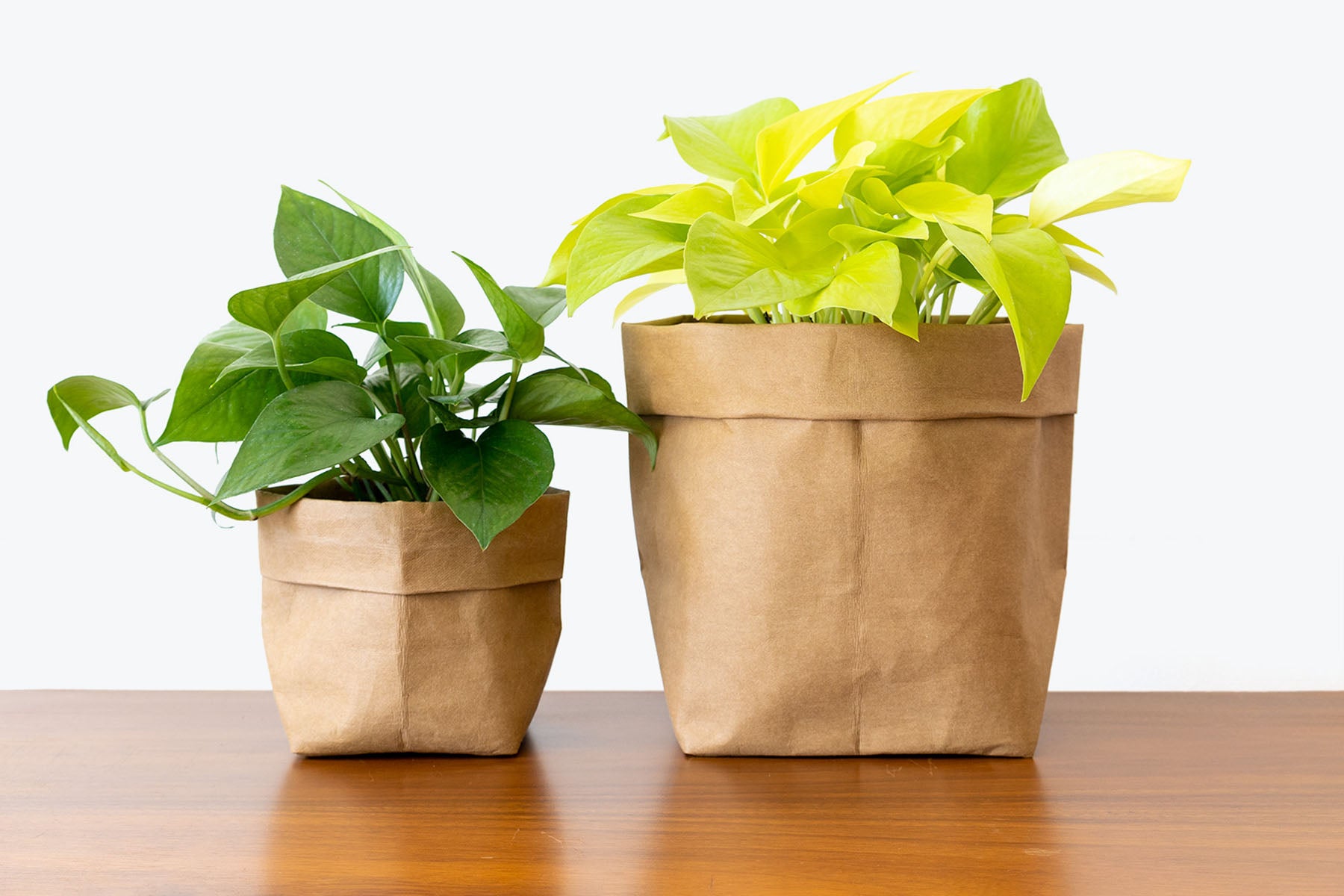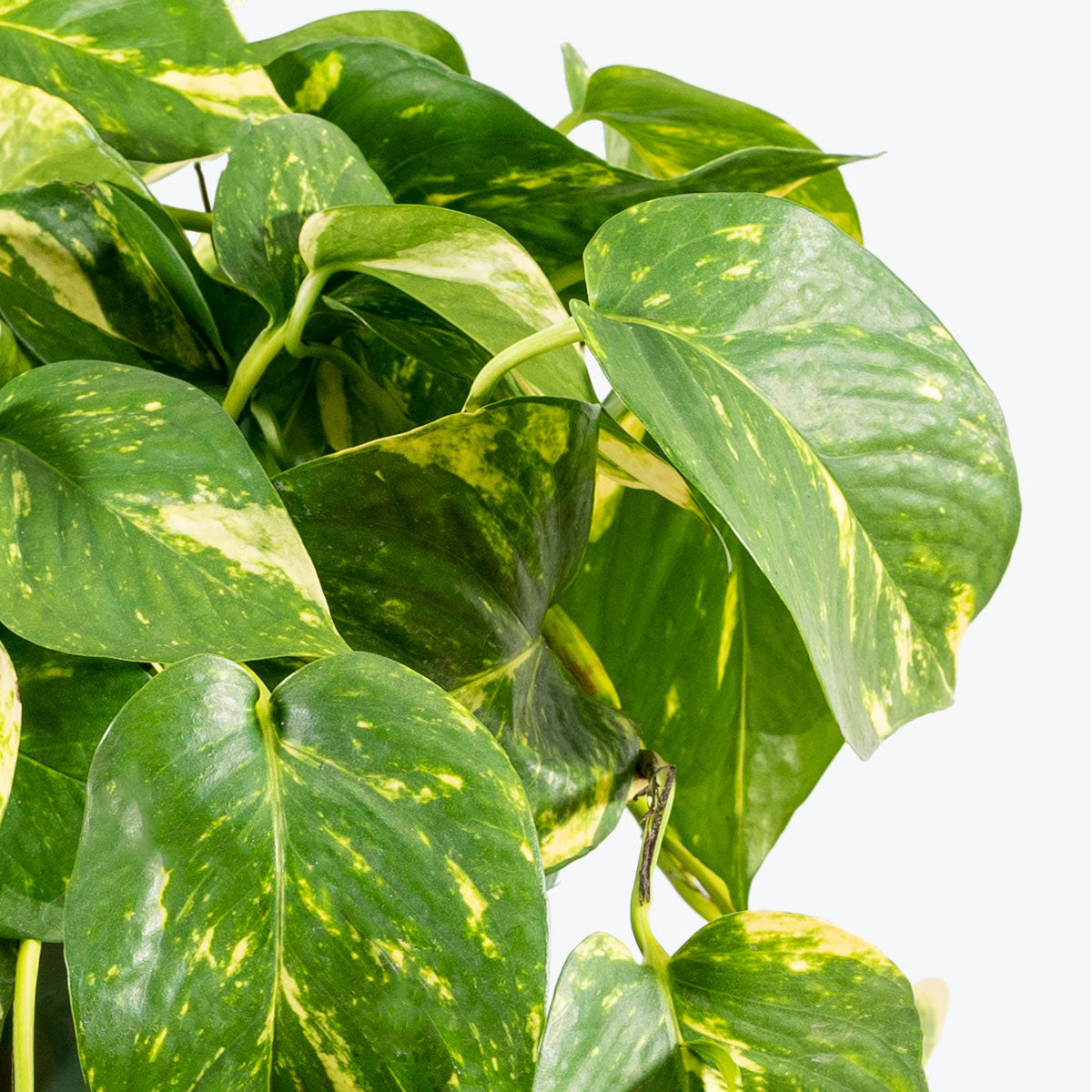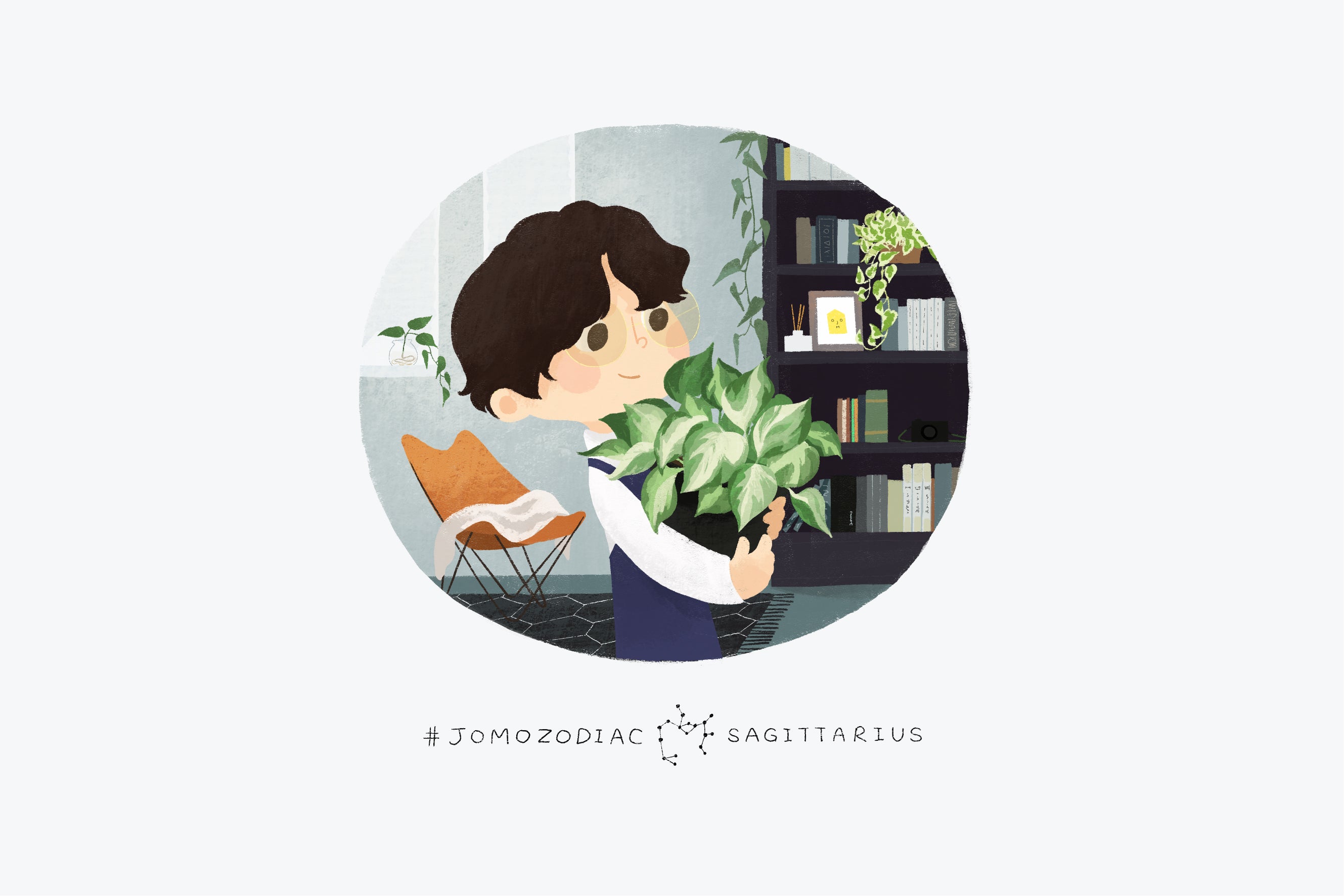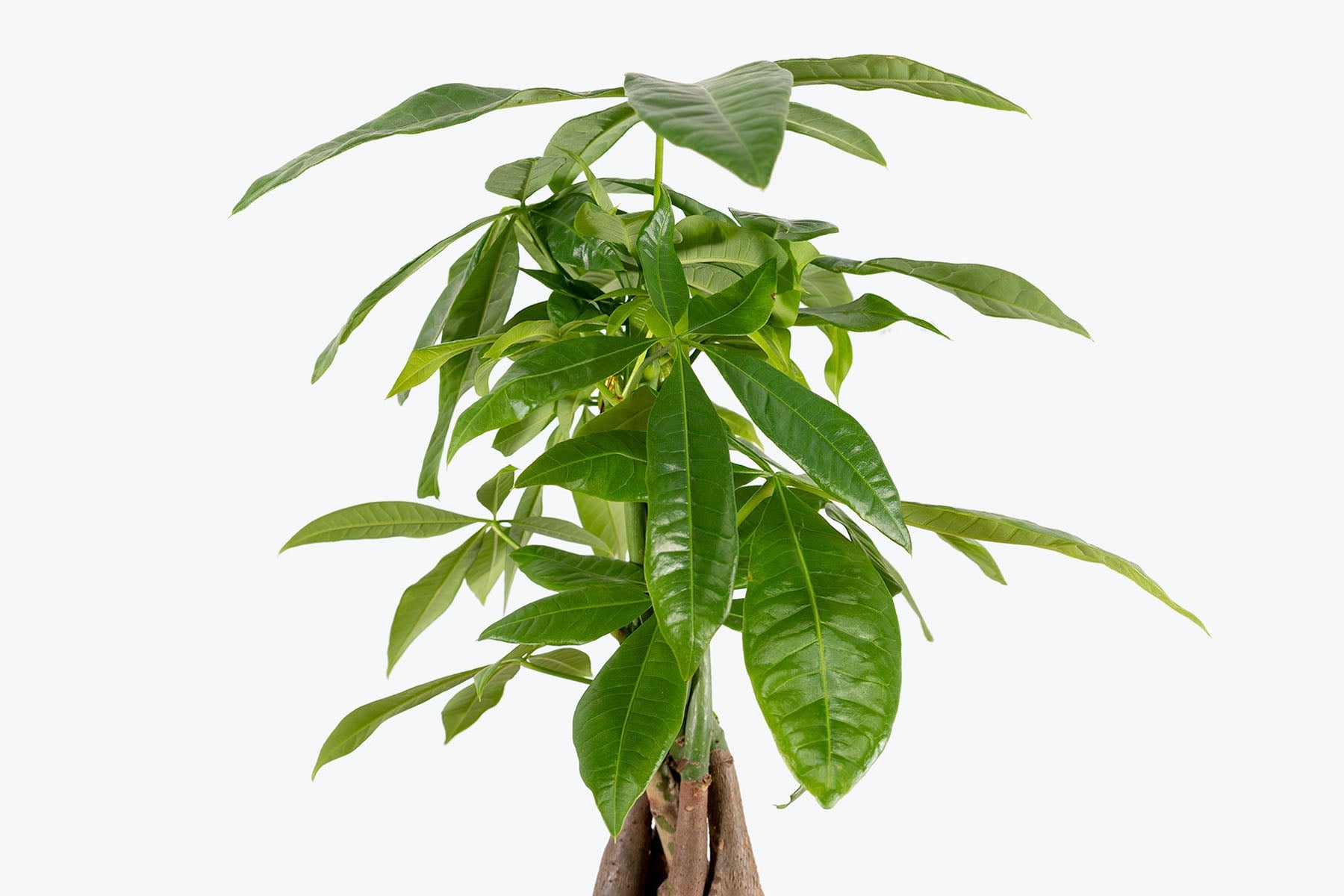
How to Take Care of Your Pothos
If you are looking for an easy-care, trailing houseplant that purifies the air, thrives off of neglect and adapts to your home conditions, a Pothos plant may be the one for you! If the previous sentence didn't sell you on them, keep on reading to find out how amazing this genus of plants is and how well they can grow in the average home. The fact that they can provide an incredible, tropical feel to your home, with such a simple care regime, makes them incredibly attractive to lots of plant owners, beginners and experienced alike.
△ 6" Golden Pothos
Pothos, aka Devil's Ivy or Money Plant, are a part of the Epipremnum genus, which belongs in the Araceae family, commonly known as aroids, along with Alocasia, Philodendron, Monstera, and Anthurium. For Pothos, in particular, their trailing, vine-like habit is how they adapted in the wild, growing on jungle floors and latching to the towering trees with their aerial root systems. These aerial roots are the roots that grow along the stems of the plant, completely out of the soil in the air, where they latch onto structures for support as well as accumulating moisture and nutrients from the air and wind.
💡
If you want to try something new, rather than letting your plant trail, give your plant a trellis, totem, or some other support made out of natural materials to grow on! They may not necessarily cling on to the support on their own in our homes, due to the lower humidity and different light levels, but they can always be hooked or tied to the support to encourage this growth. This can encourage very large, mature leaves on some varieties, but it is also just a cool, unique way to display your plant.
Although Pothos and Philodendrons are often confused with each other, Pothos have thicker, textured, waxier leaves, with grooved stems and more of a spade-shaped leaf. Another major difference between the two is their growth habit, where a new Pothos leaf extends and unfurls from a current leaf, while a new Philodendron leaf extends on a bit of vine in a cataphyll, or waxy sheath. That being said, they are both relatively quick growers, depending on how much light they are receiving of course, and incredibly durable.
Not only are Pothos a great addition to any room in your home, as they can handle the majority of light levels, excluding prolonged direct sun or no light at all, but they are also extremely effective at purifying the air of certain household toxins. Specifically, they filter and cleanse the air of formaldehyde, benzene fumes, and carbon monoxide, making them a beautiful and healthy addition to your space.
✂️
Another great part of Pothos care is that they are easy to propagate! This can either be done by water propagation (which will look very cute in a glass jar on a window sill) or soil propagation. To do so, use clean sheers to snip off a vine, with at least 2 leaves, and remove the leaf on the node closest to the cut end. This node will be placed in the soil or water, as that is where the new roots will grow from (otherwise, make sure at least an aerial root is kept submerged, as this will also grow as the new roots of the plant). With these cuttings, you can either make the original plant more full or you could start a whole new plant!
For those of you who don't have much time to allot to plant care but still want some greenery in your home, the Pothos will be your best friend. They grow quickly, add a jungle vibe to your home, can withstand periods of neglect, thrive in average home humidity, and are often very affordable. There are also quite a few varieties to choose from, which we will go over in the next section, coming in many sizes!
Although their care is quite straightforward, we still want to make sure your plant is as happy as can be, so keep reading to find out the lighting needs, watering needs, and any potential problems your Pothos could run into.
Light Requirements
For most Pothos varieties, they can be placed almost anywhere in your home. From a brightly lit window all the way down to the other side of a room with a bright window. The main thing that they cannot handle is prolonged, direct, afternoon sunlight, as this could burn their leaves or cause pale growth. Although they can handle most light on the spectrum of indoor lighting, keep in mind that their growth habits will change depending on the light they are receiving. Check our Ultimate Lighting Guide for all the light levels possible in a home.
△ 4" Neon Pothos
Light levels also change throughout the year, as there is a lot more light during the longer, warmer days of spring and summer, and a lot less light in the shorter, cooler days of the winter. You may have to move your plant in order to avoid too much light or not enough light. As long as your plant can "see" the sky from where it sits, then it will be receiving some sort of natural light, which is necessary to support its growth.
🌱
Try not to be concerned about every yellowing leaf on your plant. If there are no pests on your plant and it is pushing out healthy, new growth, your plant will shed its older leaves over time, sending the energy to this new growth. Yellowing leaves are all a part of the natural process.
The lowest light conditions that Pothos plants can handle include the following:
- A few meters back from a South, West, or East facing window
- A few feet away from a North-facing window
- Next to a South, West, or East facing window that is facing a courtyard or is blocked by a nearby building
Many plants are sold saying that they thrive in low light, however, that is not necessarily the case. There are quite a few options for plants that can be placed in lower light spaces, but they won’t thrive in it, they will tolerate it. They will more often just retain the shape that they come in, or become “leggy”, where their leaves are more spaced out and growth is less compact. The rate of growth will also be slower, the size of the new leaves will probably be on the smaller side, and there may even be some leaf loss, as plants will shed what they can't support. Keep this in mind when you are choosing where to put your plant.
☀️
Rotate your plant every week to get even growth on all sides!
In that case, here are some ideal light conditions for you to keep your plant looking nice and full:
- Next to, or close by, a South, Southwest, or West-facing window that has sheer curtains for some bright, indirect light (they cannot handle prolonged, direct sunlight so the curtains keep the leaves from getting burned)
- About 5-10ft away from a South, Southwest, or West-facing window without curtains
- Next to a North or East-facing window
Pothos will thrive in medium to bright, indirect light, producing lots of glossy, perky, healthy new growth! That being said, there are quite a few varieties that exist, each having slightly different light needs than the next, to support their unique colourings. If a variety has any sort of variegation, which is when there is the appearance of different coloured zones on a leaf (such as yellow, white, or lime green), it will most likely need more light to support this variegation in order for the plant not to revert back to solid green. Let's go over each variety:

Pothos Jade:
With their large, dark green leaves, the Jade Pothos will not need extremely bright light, as the green colouring will allow for extremely efficient photosynthesis. Keep them in low to bright light.

Pothos Golden:
This variety is extremely popular, with its stunning yellow variegation throughout the leaves. That being said, since there is some variegation, the less light the plant receives, the higher the chances of the plant losing some of the colouring over time. Keep them in medium to bright light.

Pothos Neon:
Another variety with solid colouring, the chartreuse colouring of Neon Pothos leaves will brighten up a darker corner of your home, as the colouring of these beauties will do just fine in lower light settings. Keep them in low to bright light.

Pothos Marble Queen:
With cream and white streaks throughout the leaves, the Marble Pothos is a great option for medium to bright light locations! Even though their variegation is consistent and reliable, there will be higher chances of some loss of colour over time if they are in a lower light setting.

Pothos Hawaiian:
Similar to the Golden Pothos, but with much more extreme yellow variegation, the Hawaiian Pothos variety will definitely need brighter light to support this variegation. Keep them in medium to bright light.

Pothos Pearls and Jade:
Just like the other variegated varieties, Pothos Pearls and Jade will need brighter light to support their beautiful, small, cream-variegated leaves. Keep them in medium to bright light.

Pothos Manjula:
Pothos Manjula has large, heart-shaped leaves and their slightly wavy edges are covered in vibrant markings of creams and greens. It is one of the more unique and rare cultivars of Pothos at this time, a true sight to be seen. Keep them in bright light.
With medium to bright light, Pothos can be relatively quick growers, trailing up to 10' long in the home! If you want your plant to remain full and bushy though, trim the longer vines every few months, this will encourage the plant to develop more side-shoots and reduces the demand for the plant to develop a larger root system while confined. Also, trim any dead, discoloured, damaged, or diseased leaves and stems as they occur. Use clean, sharp scissors to avoid tearing or bruising the stems.
💡
When trimming, whether due to leggy growth or to encourage a fuller plant, use the trimmed pieces to either fill the mother plant or to grow a whole new plant!
Watering Requirements
One of the great things about all Pothos varieties is that they are not very thirsty plants! In fact, it would be more damaging to the plant if it was to receive too much water, rather than too little. Allow your plant's soil to mostly dry out before watering again, at least the top three-quarters of the plant can be dry before giving it another drink. If you are ever confused, your plant will communicate to you when it is thirsty when the leaves begin to droop or wilt, looking a little softer than when the plant is fully watered and perky.
🚨
Don't let your plant get extremely wilted though, as this can cause brown tips on your plant, as well as resulting in some leaf loss! Also, letting your plant go from extremely dry to extremely soaked often can stress a plant out, which can lead to browning on leaves and leaf loss as well. Although they will tolerate missed waterings, you never want to let it go too far.
As for the frequency of watering, or how often to water, that will all depend on the light your plant is receiving, the warmth and humidity of your home, the size of the pot, as well as the pot that the plant is planted in. Generally, no two plants will be on the exact same watering frequency, as everyone's home is different! You should expect to water your plant more often in the spring/summer months though, when the days are longer, warmer, and brighter, and less often in the winter months when the days are shorter, cooler, and darker. You should also expect to water a plant that is receiving higher light more often than the plant that is receiving lower light.
△ 4" Pothos N’Joy
Water your plant until the soil is fully saturated and there is water coming out of the drainage holes. If the soil is not absorbing the water, try bottom-watering your plant instead, where you let it sit in a bowl of 2-3 inches of water for roughly 30-45 minutes, until the soil has absorbed some water. Then, in either case, let any excess water drain out and dump any excess water! Wait until the soil is mostly dry before watering again.
📋
If your Pothos is drooping no matter how much you water it, or if there are lots of roots compared to soil and they are coming out of the drainage holes, your plant may need to be repotted. When a Pothos is root-bound, it will not be very happy, but once it gets a new home, it will perk right back up! You can read all about how to repot in our step-by-step guide here.
Pothos plants love chunky, well-draining soil, which will keep the soil from staying too moist for too long. As long as there is some sort of aggregate in the soil, such as perlite, vermiculite, charcoal, lava rocks, orchid bark, or coconut coir, the soil will not become too compact and will allow for some airflow throughout the soil. They thrive in nutrient-rich soil, but can also handle nutrient-poor soil, which is another thing that makes them so desirable.
Humidity
Pothos are not too picky when it comes to humidity and temperature, if you're happy, your plant is happy. Even though they are just fine in average home temperatures, they still prefer warm, humid environments as they are tropicals of course! So if you have the time, and want to make the effort, you can:
- Place the nursery pot on top of a bed of rocks that are covered in water, which increases the humidity in the air around the plant
- Mist your plant multiple times daily to increase the ambient humidity around your plant
- Purchase a humidifier and keep it in the same area as your plant when turned on
Remember that just because they are fine with average humidity and temperatures, they still won't enjoy drafts, from heating vents, A/C vents, or open windows. Low humidity and dry soil can lead to brown edges and droopy foliage.
Fertilizing
For fertilizer, Pothos are not too picky and they really don’t need it that often as they grow quite easily. Fertilize once a month through the Spring and Summer months and then do not fertilize throughout the Winter. Use a general-purpose, indoor plant fertilizer that any greenhouse, garden centre, or plant shop offers! Make sure the soil is damp before fertilizing, otherwise it could burn the roots. Finally, never fertilize a plant that is already stressed out (i.e. soaking wet, extremely dry, lost a lot of leaves, etc.), as this will only enhance the stress.
Toxicity
Since they are toxic to both humans and pets, due to the calcium oxalate crystals that all parts of the plant contain, Pothos are best kept away from children and animals. If ingested, depending on how much, they can cause eye irritation, mouth irritation, tongue swelling/irritation, swelling of the throat, pawing at the face, and possible vomiting. The juices from the plant can also irritate your skin, leading to a rash if you are very sensitive, so make sure to use gloves when working with them or wash your hands after handling them. Keep out of reach of your children and pets, especially if they are curious.
Common Pests & Problems
Keeping in line with their great reputation as houseplants, Pothos don't have too many problems when it comes to pests and other issues. That being said, even though most of these problems don't occur all the time, we still want to outline any possible issues you could experience while having them in your care:
Over-watering:
When a Pothos has received too much water, this will lead to yellowing leaves, rotting stems, or brown, rotting spots on the leaves. Once this happens, make sure the plant is getting enough light and then ease up on how much water you have been giving your plant, see our guidelines above.
Under-watering:
On the flip side, if a plant hasn't received enough water, it will start to lose its leaves, as it can't support them with not enough moisture. It can also lead to dry edges or tips of the leaves. Make sure to not let the plant go from dry to soaking wet too often.
Pale/ Bleached Leaves:
When a Pothos receives too much light, the foliage, either new or old leaves, can become bleached and lose some of its rich colouring. If so, move your plant to a spot where it won't receive as much light, just don't move it to the dark.
Thrips:
If new leaves are deformed or there are yellow spots/yellowing of leaves (not just the older leaves dying off) you may have a case of thrips. They are very small, skinny bugs. Remove any extremely damaged leaves, take your plant somewhere to wash it all off, allow it to dry off, then treat the entire plant (stems/vines included!) with a neem oil mix or an insecticidal soap. See our complete guide to getting rid of them here.
Mealybug:
If you notice clumps of white fuzz throughout the plant and small white mounds, you may be experiencing mealybugs. Wash the plant off and allow the leaves and stems to dry off, then treat the entire plant with a Neem oil mix or an insecticidal soap. You can read more about how to get rid of mealybugs here.
Spider Mites:
If you see a sticky residue on the undersides of the leaves and tiny webbing all along the leaves, wash the plant off and allow the leaves and stems to dry off, then treat the entire plant (stems included!) with a Neem oil mix or an insecticidal soap. See our complete guide to getting rid of them here.
Although there are pests that can bother a Pothos, they can be quite easy to get rid of, as long as you stay on top of the treatment. If your Pothos is already unhealthy from poor lighting, a nutrient deficiency, or improper soil moisture, it is much more susceptible to pests. Weakened or stressed plants will attract the piercing mouths of the insects exhaust your plant and accelerate yellowing.
With all that being said, Pothos are a great addition to your home because they are incredibly strong plants and they are a breeze to take care of.









